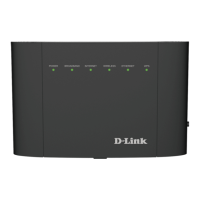
Do you have a question about the D-Link DSL-3785 and is the answer not in the manual?
| Wi-Fi band | Dual-band (2.4 GHz / 5 GHz) |
|---|---|
| Wi-Fi standards | Wi-Fi 5 (802.11ac), 802.11b, 802.11g, Wi-Fi 4 (802.11n) |
| Top Wi-Fi standard | Wi-Fi 5 (802.11ac) |
| WLAN data transfer rate (max) | 1167 Mbit/s |
| WLAN data transfer rate (first band) | 300 Mbit/s |
| WLAN data transfer rate (second band) | 866 Mbit/s |
| Ethernet LAN | Yes |
| Networking standards | IEEE 802.11ac, IEEE 802.11b, IEEE 802.11g, IEEE 802.11n, IEEE 802.1p, IEEE 802.3, IEEE 802.3az, IEEE 802.3u, IEEE 802.3x |
| Ethernet LAN interface type | Gigabit Ethernet |
| Memory card slot(s) | No |
| RJ-11 ports quantity | 1 |
| USB 2.0 ports quantity | USB 2.0 ports have a data transmission speed of 480 Mbps, and are backwards compatible with USB 1.1 ports. You can connect all kinds of peripheral devices to them. |
| Ethernet LAN (RJ-45) ports | 4 |
| 3G/4G USB modem compatibility | - |
| Product type | Tabletop router |
| Product color | Black |
| LED indicators | LAN, Power, WLAN, WPS |
| Antennas quantity | 2 |
| Mac operating systems supported | Mac OS X 10.10 Yosemite, Mac OS X 10.11 El Capitan, Mac OS X 10.12 Sierra, Mac OS X 10.4 Tiger, Mac OS X 10.5 Leopard, Mac OS X 10.6 Snow Leopard, Mac OS X 10.7 Lion, Mac OS X 10.8 Mountain Lion, Mac OS X 10.9 Mavericks |
| Windows operating systems supported | Windows 10, Windows 10 Education, Windows 10 Education x64, Windows 10 Enterprise, Windows 10 Enterprise x64, Windows 10 Home, Windows 10 Home x64, Windows 10 IOT Core, Windows 10 Pro, Windows 10 Pro x64, Windows 7 Enterprise, Windows 7 Enterprise x64, Windows 7 Home Basic, Windows 7 Home Basic x64, Windows 7 Home Premium, Windows 7 Home Premium x64, Windows 7 Professional, Windows 7 Professional x64, Windows 7 Starter, Windows 7 Starter x64, Windows 7 Ultimate, Windows 7 Ultimate x64, Windows 8, Windows 8 Enterprise, Windows 8 Enterprise x64, Windows 8 Pro, Windows 8 Pro x64, Windows 8 x64, Windows 8.1, Windows 8.1 Enterprise, Windows 8.1 Enterprise x64, Windows 8.1 Pro, Windows 8.1 Pro x64, Windows 8.1 x64, Windows Vista Business, Windows Vista Business x64, Windows Vista Enterprise, Windows Vista Enterprise x64, Windows Vista Home Basic, Windows Vista Home Basic x64, Windows Vista Home Premium, Windows Vista Home Premium x64, Windows Vista Ultimate, Windows Vista Ultimate x64, Windows XP Home, Windows XP Home x64, Windows XP Professional, Windows XP Professional x64 |
| Security algorithms | WPA, WPA2, WPS |
| AC input voltage | 100 - 240 V |
| Power source type | AC |
| Storage temperature (T-T) | -20 - 70 °C |
| Operating temperature (T-T) | 0 - 45 °C |
| Operating relative humidity (H-H) | 10 - 95 % |
| Certification | CE, LVD |
| Depth | 150 mm |
|---|---|
| Width | 210 mm |
| Height | 30.75 mm |
| Weight | 113.05 g |
Records changes made to the manual over time.
Lists company and product trademarks mentioned.
Details the device's energy efficiency and power consumption.
Lists items included in the box with the router.
Specifies hardware and software needs for setup.
Provides a general overview of the router's capabilities and features.
Highlights the key functionalities and benefits of the device.
Describes the physical components and ports of the router.
Details ports and connectors located on the rear of the router.
Details buttons and indicators located on the side of the router.
Explains the meaning of the status indicator lights on the router.
Preparation steps and information needed before starting installation.
Tips for optimal router placement to maximize wireless signal.
Step-by-step instructions for manually configuring the router.
Step-by-step guide for initial router configuration using the wizard.
How to log into the router's web-based interface.
Configuring WAN connection types and viewing status.
Configuring Wi-Fi SSIDs, security, and Guest Zone.
Configuring LAN IP address and DHCP server settings.
Configuring access to USB storage devices connected to the router.
Configuring Firewall, Access Control List (ACL), and IP/MAC Filtering.
Configuring Port Forwarding, DMZ, Static Routing, Dynamic DNS, and Web Filter.
Managing time, logs, system settings, firmware upgrades, and diagnostics.
How to physically connect a USB storage device to the router.
Steps to access USB shared files from a Windows PC.
Steps to access USB shared files from a Mac computer.
Using WPS for easy and secure wireless connection.
Steps for connecting to the wireless network from Windows.
Information on securing wireless networks with WPA/WPA2.
Resolving issues preventing access to the router's interface.
Steps to reset the router if the administrator password is lost.
Troubleshooting problems connecting to specific sites or sending emails.
Explains wireless concepts, D-Link benefits, and how wireless works.
Differentiates between Wireless Local Area Network (WLAN) and Wireless Personal Area Network (WPAN).
Discusses where wireless is used and its advantages.
Verifying the computer's IP configuration using ipconfig.
Manually configuring IP address, subnet mask, and DNS settings.
Details on different levels of wireless security like WPA/WPA2.
Lists physical ports, wireless standards, and ADSL/VDSL standards.
Details power input/output, operating temperature, and humidity.
Provides the physical measurements and weight of the device.
Specifies radio frequency bands and maximum output power compliance.
Contains conformity statements for the European Union.
General safety guidelines for product use and handling.
Guidelines for environmentally sound disposal and recycling.